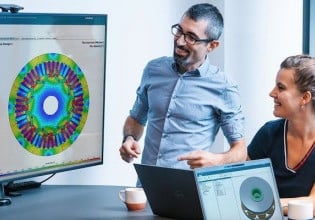Electrolyte Formula Gives Lithium-ion Batteries a Charging Boost
A research team has developed an electrolyte formula for lithium-ion batteries that improves charging speed and battery lifespan.
Every year when Apple unveils its latest iPhone model, improved charging speed is often a selling point. No one wants to wait for their device to be fully charged. But making charging as fast as possible is about more than mere convenience when it comes to the electric vehicle (EV) market. Quick charging is a core facet of lithium-ion battery (Li-ion) functionality.
Electric vehicle fast-charging stations. Image used courtesy of Federal Highway Administration
The lack of fast-charging stations in many regions makes it difficult for drivers to recharge easily during a commute. The Environmental and Energy Study Institute (EESI) mapped the United States infrastructure for EVs as of 2021, and while the West Coast and Northeast regions are steadily increasing charging station numbers, many regions of the U.S. are lagging.
Charging station density map. Image used courtesy of EESI
Charging speeds and battery life spans can dramatically impact EV ownership and discourage prospective buyers who prefer the convenience of the familiar and the confidence that they can easily find a gas station.
Industry insiders have named this consumer preference for combustion engines and worry about EV charging accessibility “range anxiety.” Until there is a perceptual tipping point and charging stations are commonplace, buyer trepidation is likely to persist. Last year in 2022, the U.S. installed 6,300 fast charging stations, but that is hardly enough to alter public perception.
This context of gradual charging station growth and stubborn public perception is important for grasping the importance of recent innovations at the battery level that might make significant improvements to fast-charging accessibility.
One innovation comes from researchers at Oak Ridge National Laboratory, who have devised a way to speed up ion flow in EV batteries.
Li-ion Safety Challenges
The push to perfect Li-ion battery performance is complex. Improvements cannot be myopically focused on elevating battery performance; safety, cost, and environmental impact must all be carefully considered with every change made to battery components.
Diagram of lithium-ion battery cell components. Image used courtesy of UL Research Institutes
Thermal instability is one major concern that arises as researchers experiment with battery components.
Thermal runaway can happen when the integrity of the separator between the cathode and anode is compromised, and it is also caused by overcharging, external short circuits, and extreme temperature conditions on either the high or low end.
Regulatory control has maintained safety as the EV market grows, and actual incidents of fire or explosion are rare. EV fires seem to exist more prominently in the public imagination than in reality. Although EV battery fires can be difficult to extinguish, they aren’t common, according to a study by the Pacific Northwest National Laboratory.
Improving Electrochemical Performance
But when researchers push the envelope in terms of battery performance, safety risks are always a concern. When it comes to extreme fast-charging (XFC), engineers strive to expand performance limits while preserving safety, and a research team has recently struck this delicate balance in a new and exciting way.
The battery scientists at Oak Ridge National Laboratory have created a novel combination of lithium salts and carbon solvents in an electrolyte formula that improves ion flow in the battery cell.
This innovative electrolyte formula not only improves ion flow but can do so even when the current heat increases as a result of XFC.
The data on the performance of this formula shows marked improvements. The battery is able to recharge to 80 percent of its full capacity in 10 minutes and can maintain this ability for 1,500 charging cycles. The Department of Energy (DOE) establishes specific guidelines for the lifespan of batteries, and this electrolyte formula triples the DOE target for the lifespan of an XFC battery.
Leaps forward in Li-ion technology like this one will make fast charging more accessible. Increased accessibility will in turn transform consumer perception of EV ownership, thus moving us closer to clean energy targets and EV market dominance as the old combustion engine becomes a novelty of the past.









